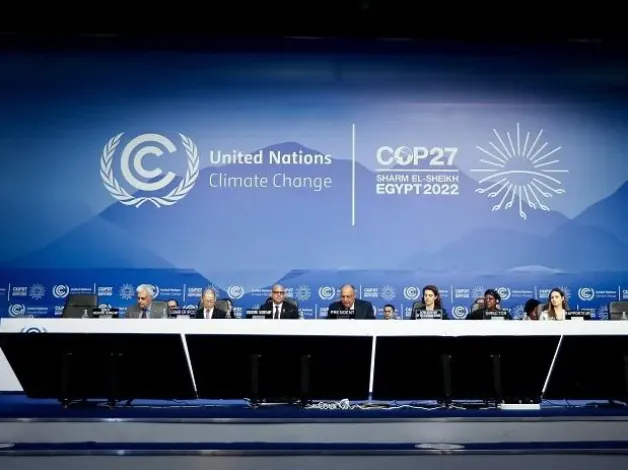-
CENTRES
Progammes & Centres
Location
The importance of the L&D fund hardly needs a reiteration. But the question that arises is how to address it.

Establishing the Loss and Damage (L&D) Fund is a significant milestone reached at the COP27. This is the culmination of years of relentless advocacy by developing and less developed nations severely impacted by the forces of global warming and climate change. The primary objective of this fund is to extend financial assistance to nations facing adverse impacts from the consequences of climate change. This witnessed the establishment of a Transitional Committee, comprising 24 members from various geographies, for overall supervision of the fund’s operations. The Committee’s terms of reference entail providing recommendations to be tabled at COP28, in Dubai, the United Arab Emirates (UAE), in December 2023.
The primary objective of this fund is to extend financial assistance to nations facing adverse impacts from the consequences of climate change.
As the climate crisis worsens, its impacts like rising sea levels, persistent heatwaves, desertification, ocean acidification, and changing frequency of floods, droughts, cyclones, and bushfires will result in losses and damages for human society that are long-term and often permanent. The framework of the United Nations Framework on Climate Change Convention (UNFCCC) acknowledges that climate change has led to some “irreversible impacts” that cannot be reduced by adaptation. In most cases, these losses and damages are borne by those who are the least emitters. As an example, the African continent, despite its least contribution to global climate change, remains one of the most climatically vulnerable landmasses, whereas the G20 nations are responsible for around 75 percent of global greenhouse emissions. Therefore, from the perspective of climate justice, distributive justice, and equity, the affected need to be compensated.
As the climate crisis worsens, its impacts like rising sea levels, persistent heatwaves, desertification, ocean acidification, and changing frequency of floods, droughts, cyclones, and bushfires will result in losses and damages for human society that are long-term and often permanent.
According to the United Nations Environment Programme’s 2023 Adaptation Gap Report, the financial requirements for adaptation in developing countries exceed the international public finance flows by a factor of 10 to 18, representing an increase of over 50 percent compared to earlier estimates. Current models project that the cost of adaptation in these countries will amount to approximately US $215 billion annually throughout this decade. Moreover, to address domestic adaptation priorities effectively, these nations will require an estimated US $387 billion each year. As such, loss and damage financing needs to be closely linked with adaptation and mitigation financing.
In 2013, the UNFCCC established the Warsaw International Mechanism (WIM) to address L&D issues. However, its primary focus remained skewed towards risk management, with inadequate efforts in stimulating global financial action. The critical limitation of this strategy is closely mirroring the approaches used for mitigation and adaptation. The very purpose of WIM’s creation was to address the impacts of climate change that are beyond the scope of mitigation and adaptation. Therefore, relying on these strategies for L&D is fundamentally flawed. The Intergovernmental Panel on Climate Change has pointed out that despite robust adaptation and mitigation measures, the inevitable consequences of climate change in terms of loss and damage will persist.
Therefore, the importance of the L&D fund hardly needs a reiteration. But the question that arises is how to address it? That will be the prime concern that will plague the flow of funds in the L&D kitty. This “how” question arises from four heads, as we classify in this essay.
The first and foremost concern is with the very delineation of L&D. The scope of ‘loss and damage’ lacks a precise definition, leaving room for interpretation. Boyd and co-authors discuss a spectrum of perspectives on L&D which can range from adaptation and mitigation to existential, which is how to address the harm done to vulnerable countries. UNFCCC’s approach has not specified which perspective it takes. The Sharm el-Sheikh Implementation Plan discusses the devastating economic and non-economic losses of L&D, including forced displacement and impacts on cultural heritage, human mobility, and the lives and livelihoods of local communities. On the other hand, damages are classified as losses to infrastructure and property that significantly impair a country’s economic, environmental, and social state. Economic loss and damage, for instance, occur when natural disasters destroy infrastructure like homes, schools, and roads—they are monetarily quantifiable. Non-economic losses like culture are unquantifiable.
The Sharm el-Sheikh Implementation Plan discusses the devastating economic and non-economic losses of L&D, including forced displacement and impacts on cultural heritage, human mobility, and the lives and livelihoods of local communities.
Further, these definitions are overarching and broad. Until an accepted definition and classification of L&D is reached, the problem with financing remains. On the other hand, literature adequately acknowledges ex-ante (before an event entailing L&D has occurred) and ex-post (when an event entailing L&D has already occurred). While the ex-ante classification aims to address and prevent L&D which could occur in the future (even WIM talks of that), the bigger problem lies with how to distinguish them from adaptation finance. This is a crucial issue.
The problem of attribution arises from various sources. The first is with respect to which aspect of loss and damage can be attributed to climate change. As an example, the Indian Sundarbans in the Ganges-Brahmaputra-Meghna delta are shrinking not only due to sea-level rise but also due to a decline in sediment flows from the mainstream Ganges to its distributaries. The decline in the sediment flow is largely due to sediment getting arrested in upstream of a barrage on the Ganges at the town of Farakka in West Bengal. Therefore, attributing the shrinkage of the Indian Sundarbans entirely to sea-level rise in the Bay of Bengal is not correct.
Further, the question is: who pays? In the whirlwind of COP27 talks, the European Union gave a nod to the Loss and Damage Fund, with a twist: only ‘major economies’ as tagged by the UNFCCC should chip in. Here’s the catch: nations like China, notorious for their hefty greenhouse gas contributions but still tagged as ‘developing’ under UNFCCC rules, blur the lines. It’s a climate conundrum that begs the question – how do we define a donor country in a warming world?
Flashback to COP26, where developed countries vowed to pool US$100 billion each year to fight climate change in the developing world – a promise still hanging in the air. Fast forward to 2025, and the price tag could soar to a staggering US$1 trillion annually, rocketing to US$1.7 trillion by 2030. And guess what? Even these eye-watering figures might just be the tip of the iceberg.
The problem of valuation of L&D has hardly been talked about so far. If “loss and damage” financing is a compensation mechanism, what should be the normative principles on which this financing can be based? There are two questions here. First of all, if a bridge, embankment, or property is lost and/ or damaged, are we going for an annual stock valuation of the loss? Or do we consider the associated opportunities lost through the losses in public goods? In that case, if a livelihood-enabling infrastructure is lost, and it takes 10 years to revive that, the loss needs to be expressed in terms of the Net Present Value (NPV) of the flow of the benefit or income loss for the next 10 years with an appropriate rate of discount. This is one element.
Further, climate change also causes losses in ecosystem services and especially provisioning services with which livelihoods are linked. The Observer Research Foundation’s research shows that the ecosystem dependency ratio which is the ratio of the values of the ecosystem services and the incomes of the community, is greater than one in many poverty-stricken regions. So, when climate change causes damages to the ecosystem structure and function thereby causing losses in ecosystem services, the poor community suffers substantially from such irreversible losses. This may take years to create an alternate system or ecosystem that can provide the community with the same benefits. Hence, future decades of losses need to be compensated by considering the NPV criterion.
Then comes the concern of the financing instruments and avenues. This needs to work as grants and not loans. Grant-based funding, free from political or trade-related biases, should be made available to Least Developed Countries (LDCs) and Small Island Developing States (SIDS). This specialised financing can leverage a range of financial mechanisms. For instance, a proposal by the Secretary-General suggests taxing windfall profits from fossil fuels as a viable option. An alternative approach involves debt swaps, where existing debts are forgiven to redirect funds toward climate responses. Further, to bring the private sector into this game, innovative products like L&D credit trading, L&D bonds, etc. need to be thought of. Regulation can also play an important role. If governments pass acts for the profit-making corporations to park 50 percent (or any specific number) of their CSR fund to L&D and adaptation, that will help the cause of overall climate finance in domains where the money is essential but lacking. This specific type of financing can be utilized to bridge the current shortcomings in climate finance organisations, such as the Green Climate Fund.
Unanswered questions are emerging from knowledge gaps. There is no doubt that L&D financing needs global consensus on definitions, collaborative efforts, and innovative financing. Yet, the institutional questions loom large: who pays? Who receives? How do we identify victims? How do we channel these funds? These questions are fundamental.
Nilanjan Ghosh is Director of the Centre for New Economic Diplomacy at the Observer Research Foundation.
Vivek Kumar is an intern at the Observer Research Foundation.
The views expressed above belong to the author(s). ORF research and analyses now available on Telegram! Click here to access our curated content — blogs, longforms and interviews.

Dr Nilanjan Ghosh heads Development Studies at the Observer Research Foundation (ORF) and is the operational head of ORF’s Kolkata Centre. His career spans over ...
Read More +
Vivek Kumar is a Programme Assistant - Forums at ORF. His research interests include macroeconomics, institutional economics, econometrics, development economics. Vivek holds a Bachelor of Arts Degree ...
Read More +